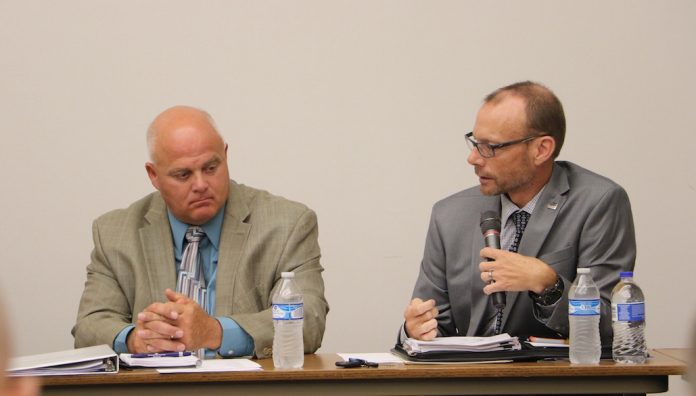
(This article was updated Oct. 12 to clarify a quote from OEPA Director Craig Butler regarding the nutrient reduction target.)
REYNOLDSBURG, Ohio — Which comes first? The science or the action?
That’s the conundrum an Ohio Soil and Water Conservation Commission task force faces in crafting its recommendation as to whether or not the commission should concur with Ohio Gov. John Kasich’s executive order to declare watersheds in the Maumee River Basin as “distressed.”
The task force met Oct. 4 to review existing research and hear from stakeholder groups.
The designation would force farmers in those watersheds to follow specific nutrient management rules. The goal is improving water quality in Lake Erie and its tributaries and reducing potential for harmful algal bloom.
The full commission is expected to vote on the matter at its Nov. 1 meeting. The task force is meeting Oct. 25, ostensibly to finalize its recommendation.
The issue isn’t whether or not there’s a problem — task force members and advisers agree there is — but whether or not the science is clear on a plan of action, if doing XYZ will improve Lake Erie water quality by X percent.
One camp believes it’s time to force Ohio landowners and operators to take action, even if the outcome is unknown. The other camp believes the state hasn’t given farmers’ voluntary practices enough time to work, that there are not enough resources to meet the requirements, and that no matter what practices are implemented, Mother Nature is still a wild card.
“This is an adaptive process,” said Craig Butler, director of the Ohio Environmental Protection Agency. “You make your best judgments based on the science you have, you put it in place, you measure it and see if you get the desired result. If you do, you stop; if you don’t, you keep forwarding, to continue to identify what your next steps are until you hit the goal.”
Butler said the designation is not an indictment against farmers nor ignores the work they’ve done to date, but focuses money, resources and policy where it’s needed most.
“We don’t have time, nor do we have the ability to answer all of those questions before we move to the next step.”
When pressed, however, by Ohio Cattleman’s Association Executive Director Elizabeth Harsh, Butler said if only livestock farmers implement all the measures prescribed under the distressed watershed designation, it’s “unlikely” that the state would hit the 40 percent nutrient reduction target identified in the Great Lakes Water Quality Agreement of 2012.
In a subsequent email to Farm and Dairy, sent by his deputy director of communication, Butler emphasized if all farmers that are in a distressed watershed comply with the proposed rules, “we do have a chance to meet the 40 percent reduction target.”
At the start of the Oct. 4 meeting, Dr. Cathann Kress, dean of Ohio State University’s College of Food, Agricultural and Environmental Sciences, presented a review of the water quality research to date. But, she added, the review raised more questions from the university’s scientists than it answered.
“We’re limited by data we don’t have on variables we don’t have,” Kress said.
590 standard
Under the distressed designation, farmers or applicators in the affected watersheds would be required to create and attest that they are following a nutrient management plan — and that could include separate plans for individual fields.
The designation would require compliance with conservation practices in the USDA’s Natural Resources Conservation Service’s Field Office Technical Guide, also known as the 590 standards, and those standards are currently under review.
Rules in the works
If the commission supports the designations, regulations crafted by the Ohio departments of agriculture, natural resources and environmental protection will kick in (link opens .pdf of document submitted to CSI). The rules are already in the works and are being analyzed for the cost of compliance by the Common Sense Initiative. The rules would then be reviewed by the Ohio General Assembly’s Joint Committee on Agency Rule Review, or JCARR.
Related coverage:
-
Farmers question whether Kasich’s executive order is practical (Oct. 4, 2018)
-
Task force weigh’s governor’s distressed watershed order (Aug. 31, 2018).
- Commission says more is needed before acting on governor’s order (July 19, 2018).
- Ohio Gov. signs executive order on Lake Erie (July 11, 2018).
- Ohio EPA to declare western portion of Lake Erie impaired (March 22, 2018).









